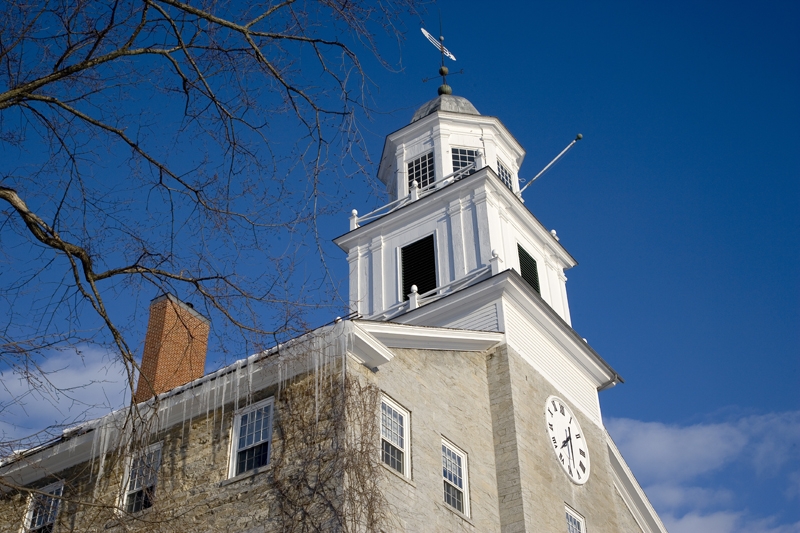Middlebury Board of Trustees Revises Governance Structure

MIDDLEBURY, Vt. -
Middlebury President Ronald D. Liebowitz and Board Chair Marna Whittington initiated a review of the board’s structure last year and appointed a Governance Working Group to make recommendations on how the board should best be organized.
“In today’s dynamic environment in higher education it is essential that governance structures support our desire to innovate and lead to meet the needs of students today and tomorrow,” said Whittington.
The working group, which was chaired by former Board Chair Frederick Fritz ’68, presented the full board with its report in October. The group’s proposal outlined a sweeping revision of the board’s committee structure in its 13 recommendations. After reviewing the report, the board asked that those recommendations be turned into a set of proposed bylaw revisions to consider at the December meeting.
Today the work of the last year culminated in the board’s unanimous passage of the bylaw changes that will go into effect July 1, 2014. The most notable changes are these:
- The number of standing committees will be reduced to six, each of which will carry a range of substantive responsibilities. These committees will be:
Prudential Committee. This body acts as an executive committee of the board with specified authorities and it will continue under the new structure, but will be reconstituted with a membership consisting of the chair and vice chair(s) of the board, the chairs of each of the five standing committees, and the chairs of the three new boards of overseers (see below). The Prudential Committee establishes goals for the president and conducts his or her annual performance appraisal. It can exercise the general duties of the trustees in the interim between board meetings.
Trusteeship and Governance. This committee will consider the general composition of the Board of Trustees and make suggestions for new trustees and members of the boards of overseers and other advisory boards that may be established in the future. It also will review bylaws and make recommendations to the full board regarding governance.
Resources. This committee will assist the board in fulfilling its oversight and stewardship responsibilities for all of Middlebury’s financial and material resources. The committee will review the annual budget and financial model, oversee Middlebury property in all locations, have general charge over the financial affairs of the Corporation, and be responsible for oversight of the investment of the Corporation’s endowment portfolio and other assets.
Risk Management. This committee will be responsible for evaluating, monitoring, and addressing all matters of institutional risk, including oversight of all operating policies and handbooks. The committee will review internal controls established by the administration and the trustees; will make recommendations to the board regarding all areas of risk (reputational, brand, financial, legal, governance, and operational); and will insure the completion of an annual financial audit.
New Programs. This committee will be responsible for evaluating and supporting new programs, partnerships, acquisitions, and joint ventures. It will review the mission, academic quality, viability, program policies, market position and prominence, and financial underpinnings of new programs after they have been established.
- The new governance structure also establishes three new boards of overseers—one for the undergraduate College, one for the Monterey Institute of International Studies (which will replace the Institute’s current Board of Governors), and one for the “Schools,” which include the Middlebury Language Schools, Bread Loaf School of English, the C.V. Starr-Middlebury Schools Abroad, and the Bread Loaf Writers’ Conference.
These boards of overseers will focus their attention on reviewing and monitoring the academic, educational, and student affairs operations of their respective institutions, including academic appointments, enrollment, and new initiatives. The boards of overseers will function like committees of the full Board of Trustees and each will be comprised of trustee overseers (current trustees), partner overseers (individuals who typically have a connection with that institution), and constituent overseers (one faculty, one staff, and one student). A majority of each board of overseers must consist of trustee overseers.
- Each trustee will sit on one standing committee and one board of overseers.
that he would step down as president on June 30, 2015, to coincide with the board’s governance vote, said that governance issues are top of mind for college and university presidents. He called the board’s action “a model for how overseers should look at their role” in a time of change. “Our board has embraced a bold new vision, and this institution owes a debt of thanks to the Governance Working Group for its thoughtful recommendations,” he said.
“This new oversight structure will help to refocus the work of the board,” said Whittington. “The new standing committees and boards of overseers will create new linkages across the institution to encourage even greater collaboration that leverages academic innovation, technology, and the excellence of our faculty and staff.”

